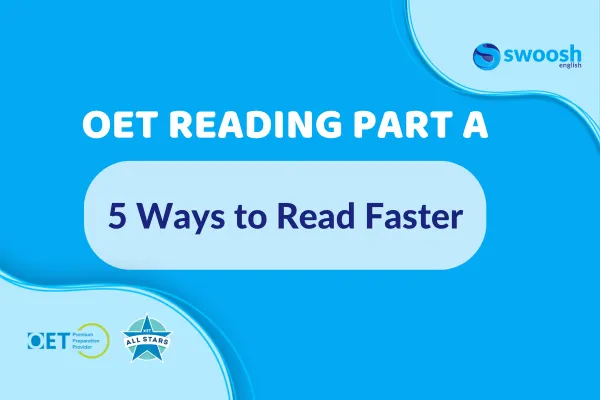Blog
Browse our library of helpful articles

5 Ways to Read Faster – Tips for OET Reading Part A
Reading swiftly poses a challenge for both native and non-native English speakers, especially when faced with the task of digesting 4 texts and answering 20 questions within a mere 15 minutes in the OET exam. To alleviate some of this pressure, here are 5 effective strategies for tackling OET Reading Part A.
1. Begin with a Skim
Start by quickly skimming through the four texts, focusing on headings and the opening lines of paragraphs to grasp a general understanding of each text's content. The initial 7 questions typically test your overall comprehension of the texts, making skimming crucial for identifying the main themes and purposes of each text.
2. Let Your Previous Reading Guide You Forward
Once you've answered questions 1-7, use your understanding of the texts to confidently tackle questions 8-20, which require specific information from the texts. Knowing which text pertains to certain topics or details will save time, ensuring efficient navigation through the exam.
3. Write Exactly What You Read
In OET Reading Part A, accuracy is paramount. Write down the exact words and phrases from the texts when answering questions 8-20, as any errors in spelling or wording will result in lost marks. Underline key words or phrases in the texts to facilitate accurate transcription without compromising time.
4. Be Prepared to Skip a Question
Time management is crucial in the OET Reading test. If you find yourself unable to locate the answer to a question within a reasonable timeframe, move on to the next question. Spending too long on a single question risks sacrificing precious time that could be better allocated to answering other questions.
5. Provide Yourself with Plenty of Practice
Practice makes perfect. Utilise mock exams and reading materials to hone your reading speed and comprehension skills under timed conditions. Seeking guidance from qualified OET teachers can also be beneficial, as they can offer personalised feedback and support to aid your improvement.
Practice
Read the text below and determine whether it focuses on:
A) The definitions and background of an illness.
B) Information relating to a medical procedure.
C) Information relating to detecting the symptoms of an illness.
Guidelines for performance of surgery in case of subdural haematoma
Surgery will be required for the majority of cases of subdural haematoma. This may be done via performance of craniotomy or burr holes.
Craniotomy:
Should be performed in the majority of cases where an acute subdural haematoma is evidenced.
Involves temporarily removing a section of the skull in order to access and remove haematoma.
Haematoma should be gently removed via suction and irrigation, enabling it to be washed away with fluid.
Section of skull to be put back in place following removal of haematoma and re-attached using metal plates or screws.
Operation typically conducted under general anaesthetic.
Burr holes:
Should be performed in the majority of cases where a subacute/chronic haematoma is evidenced.
One or multiple small holes to be drilled into the skull and a rubber tube to be inserted in order to drain the haematoma.
Tube may be left in place for up to a few days post-surgery in order to continue drainage and avoid recurrence of haematoma.
Operation typically conducted under local anaesthetic.
How much of the text did you need to read to answer the question? How helpful was the text heading?
Read the text again and answer the following questions in under a minute:
2) Which procedure needs to be conducted under evidence of a subacute haematoma?
3) Which procedure requires the use of general anaesthetic?
4) What is used to help secure the skull following a craniotomy?
Answers
B
Burr holes
Craniotomy
Metal plates or screws
Make sure you double-check your answers for accuracy, paying close attention to spelling. Practising with similar texts will further enhance your proficiency in OET Reading.
Good luck with your OET preparation and let us know if you have any questions in the comments below.

5 Ways to Read Faster – Tips for OET Reading Part A
Reading swiftly poses a challenge for both native and non-native English speakers, especially when faced with the task of digesting 4 texts and answering 20 questions within a mere 15 minutes in the OET exam. To alleviate some of this pressure, here are 5 effective strategies for tackling OET Reading Part A.
1. Begin with a Skim
Start by quickly skimming through the four texts, focusing on headings and the opening lines of paragraphs to grasp a general understanding of each text's content. The initial 7 questions typically test your overall comprehension of the texts, making skimming crucial for identifying the main themes and purposes of each text.
2. Let Your Previous Reading Guide You Forward
Once you've answered questions 1-7, use your understanding of the texts to confidently tackle questions 8-20, which require specific information from the texts. Knowing which text pertains to certain topics or details will save time, ensuring efficient navigation through the exam.
3. Write Exactly What You Read
In OET Reading Part A, accuracy is paramount. Write down the exact words and phrases from the texts when answering questions 8-20, as any errors in spelling or wording will result in lost marks. Underline key words or phrases in the texts to facilitate accurate transcription without compromising time.
4. Be Prepared to Skip a Question
Time management is crucial in the OET Reading test. If you find yourself unable to locate the answer to a question within a reasonable timeframe, move on to the next question. Spending too long on a single question risks sacrificing precious time that could be better allocated to answering other questions.
5. Provide Yourself with Plenty of Practice
Practice makes perfect. Utilise mock exams and reading materials to hone your reading speed and comprehension skills under timed conditions. Seeking guidance from qualified OET teachers can also be beneficial, as they can offer personalised feedback and support to aid your improvement.
Practice
Read the text below and determine whether it focuses on:
A) The definitions and background of an illness.
B) Information relating to a medical procedure.
C) Information relating to detecting the symptoms of an illness.
Guidelines for performance of surgery in case of subdural haematoma
Surgery will be required for the majority of cases of subdural haematoma. This may be done via performance of craniotomy or burr holes.
Craniotomy:
Should be performed in the majority of cases where an acute subdural haematoma is evidenced.
Involves temporarily removing a section of the skull in order to access and remove haematoma.
Haematoma should be gently removed via suction and irrigation, enabling it to be washed away with fluid.
Section of skull to be put back in place following removal of haematoma and re-attached using metal plates or screws.
Operation typically conducted under general anaesthetic.
Burr holes:
Should be performed in the majority of cases where a subacute/chronic haematoma is evidenced.
One or multiple small holes to be drilled into the skull and a rubber tube to be inserted in order to drain the haematoma.
Tube may be left in place for up to a few days post-surgery in order to continue drainage and avoid recurrence of haematoma.
Operation typically conducted under local anaesthetic.
How much of the text did you need to read to answer the question? How helpful was the text heading?
Read the text again and answer the following questions in under a minute:
2) Which procedure needs to be conducted under evidence of a subacute haematoma?
3) Which procedure requires the use of general anaesthetic?
4) What is used to help secure the skull following a craniotomy?
Answers
B
Burr holes
Craniotomy
Metal plates or screws
Make sure you double-check your answers for accuracy, paying close attention to spelling. Practising with similar texts will further enhance your proficiency in OET Reading.
Good luck with your OET preparation and let us know if you have any questions in the comments below.
© 2023 - All Rights Reserved

